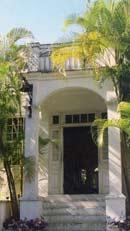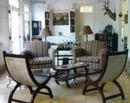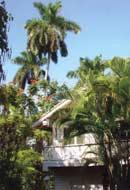The Vigia EstateThe Other Side of Hemingway
It's not strange at all to see houses, with all of their rooms, furniture, objects and items, portraying in a certain way the image of their dwellers. That's the case of the Vigia Estate in the location of San Francisco de Paula, just a couple of leagues from Havana. Today, this delightful countryside mansion –Hemingway's home for 21 years- proves that not even death can beat someone who has been touched by immortality. Visitors coming here cannot escape this almighty presence in every object and belonging that serve to immortalize the living image of its former owner.
Hemingway in Vigia Estate Ernest Hemingway made his first trip to Cuba in 1932 for a marlin fishing tournament. From that moment on, his voyages to the island were more and more often. At the end of the Spanish Civil War, he decided to settle down at the Both Worlds Hotel in Havana. The room he used to stay in now remains intact, as well as the footprints he left at El Floridita bar, the place he used to hang out with friends to sip the famous Hemingway-style daiquiri.
The American author bought the Vigia Estate in 1939 and moved there with his new wife Marta Gellhorn. That was the place he called home on a steady basis until 1960, the year he got extremely ill and decided to abandon Vigia. There he cherished his 9,000 books, plus four dogs and 57 cats. There he spent the most productive years of his career as a writer. In that countryside getaway, he wrote lots of his most celebrated works: For Whom the Bells Toll, Through Rivers and Trees, The Old Man and the Sea, Paris was a Party, and Islands in the Stream. In all of them, Cuba is present in the sea, its landscapes and characters.
The Vigia Estate was a lovely place to live, so the American novelist used to spend hours there, writing his books and short stories. Some afternoons were reserved for reading time, slouched in his favorite armchair. From that same chair, he used to chat with friends for hours. He also bred roosters there. Following a trip to Europe in 1943, Hemingway came back with Mary Welsh, the woman who eventually became his fourth wife. Marta has walked out on him shortly after they had moved to Vigia. With Mary, the Vigia Estate turned out to be the writer's getaway, a magnificent property atop a knoll that provided a distant view of the Gulf Stream.
As Gabriel Garcia Marquez wrote in the forewords to Norberto Fuentes's book Hemingway in Cuba, perhaps we should speak of two different Hemingway: the happy-go-lucky and easy-going man who loved bullfighting, boxing and hunting, and the solitary Hemingway who dwelt in Vigia Estate, in a house hedged with huge trees and spacious rooms where he kept the trophies that the adventurous side of him used to bring back home as keepsakes of his deeds. El Papa, as his Cuban friends used to call him, was a man who walked around the house wearing nothing but shorts, with a .22 gun holstered in his belt and a glass of booze in his hand. Some other times he was just seen traipsing around the property, lost in his thoughts, or simply rooting and shouting during rooster fights. There were times when he was nothing but a humble angler who took to the sea aboard his boat El Pilar, with a mystical character in tow: Gregorio Fuentes, the boat skipper and partner of multiple fishing sprees for over twenty years.
The Hemingway Museum The house has been preserved as a museum, just the way the writer left it when he abandoned it. In there, the living room keeps the original furniture; the magazine rack; his favorite armchair and the Oriental carpet that covers the floor, on which several times he propped his .256 Maunlicher Schoenauer rifle to jokingly show his friends how he was going to kill himself one day. Hanging on the walls are the trophies of his countless African safaris, as everlasting tokens of the clash between life and death. Some outstanding pieces are the impala, the bison, the grand kudu that dominates the dining room, the lion and the leopard that look spooky from outside the library, and the buffalo that hangs magnificently from one of the master bedroom's walls.
The dining room's original furniture set is still there, including the table and the chinaware the way Hemingway himself used to have it set to share a good meal with next-door friends, either humble people from the surroundings or boldface names from literature and the filmmaking industry. The same happens with the rest of the furniture, especially with a small centerpiece table where several carvings made by Cuban aboriginal Indians remain on display. The Cuban Tourism Institute gave the writer those artifacts as a gift back in 1956. Next to the objects lies the head of a pronghorn antelope he himself hunted up in the mountains of Idazo.
The library -it was originally a guest room- features pieces of furniture made of majuagua, one of Cuba's precious wood. The round cushion in the center of the room, bought by Ernest and Mary in Cairo, accompanies a set of bookends and a picture of El Pilar boat atop the mantle, alongside barometers, dry corals and other valuable pieces.
Hemingway's bedroom -that also doubled in brass as a study- is sort of a small personal museum given the number of belongings and objects that it treasures: books, his personal desk with drawers full of objects (photos, drawings, maps, insignias seized from German troops in France, the key to the city of Matanzas handed to him in 1957, carvings bought in Africa), his large moccasins with worn soles, the metal-rimmed spectacles, the collection of Nazi daggers, rifles and fishing rods. The bedstead and mattress where he used to put his mail is also there, and close to it his typewriter, in front of which he spent long hours, on his feet, pegging away at it and churning out those monumental works that have overcome the borders of time and space. All of the above and many other exotic objects make up a peerless collection worth taking a long look at.
On one side of the house, a tower built in 1947 keeps more secrets than the ones that actually leaked out. Today, the first floor (formerly used to accommodate cats) serves as a perfect setting for nonpermanent exhibits of fine works by well-known Cuban artists. The second floor has a hall devoted to hunting and fishing, featuring a photo of Hemingway taking part in the 1960 Marlin Fishing Tournament in Havana. From that year on, by the way, the event was officially renamed as the Ernest Hemingway International Marling Fishing Tournament, as well as a colloquium that takes place every two years and that was named him. The tower's top floor safeguards a collection of objects that Hemingway loved dearly, including his vest, the working table, his paintings, especially one that depicts the U.S. writer on a safari trip in Africa.
The Ceiba, the Gardens, the Pilar Boat… But Hemingway's presence is not only felt around the house. It's up in the air, around the ceiba that keeps the house's gateway –it's now a replica of the one that grew there when he was alive and whose roots were putting the whole mansion in harm's way.
Another standout in the gardens of Vigia Estate is the Pilar Boat, another real-size replica of Hemingway's yacht. The boat was donated to the museum by Gregorio Fuentes following the writer's death. Time impairment had already played havoc with the vessel, a condition that prompted an all-out restoration to make it an exhibition-worthy piece.
The estate's gardens are decorated by all kinds of vegetables, flowers and plants, including eighteen different mango species. Another must-see for visitors is the cats' graveyard. It's right next to the dining room's doorway. The dogs' cemetery, instead, was close to the swimming pool because Hemingway had set four tombstones in that place –also restored now- with the names of the canines carved in them: Blackie, Negrita, Machakos and Black Dog.
Many other corners, rooms and objects at the Vigia Estate –now the Hemingway Museum- relish precious information not only about the writer's character, tastes and interests, but also on his entire stay on the island nation. This work has solely intended to take a closer look at his favorite residence and at one of the most controversial and formidable writers of all time, a man who's also known as the Bronze God of American Literature.
Hemingway Museum Vigia Estate, San Francisco de Paula, Havana, phone: (537) 91 0809 & 21 8090 Open on weekdays (except on Tuesday) from 09:00 am to 4:30 pm.
Right now, the museum is undergoing a major section-by-section restoration effort, a work that visitors can also take a firsthand look at. The rest of the rooms remain open to the public. Entrance fees have been reduced until all restoration works are complete.






































































